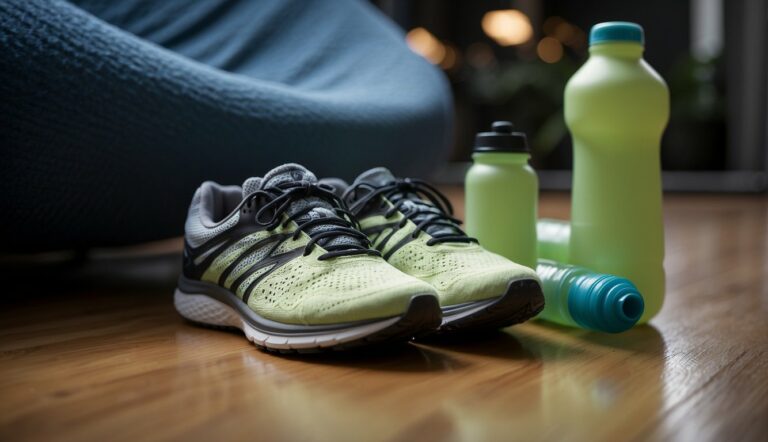How Long to Warm Up Before Running: What the Science Says!
Warming up before a run is a step you shouldn’t skip. A proper warm-up primes your body for the increased demands of running, improves your performance, and reduces the risk of injury. Aim for a warm-up routine that lasts about 5 to 10 minutes to ensure your muscles are sufficiently prepped.
During this time, focus on dynamic movements rather than static stretching. Activities like brisk walking, slow jogging, or cycling on a stationary bike are excellent choices. These exercises increase blood flow, elevate your body’s core temperature, and prepare your muscles and joints for the workout ahead.
Remember, a warm-up doesn’t need to be long to be effective. Even a short 5-minute session with focused, dynamic exercises can make a significant difference in how you feel and perform during your run. It’s about quality and specificity, so tailor your warm-up to address your needs and the specifics of your run for the day.
How Long Do You Need To Warm Up Before a Run?
A proper warm-up primes your muscles for performance and helps prevent injury. Aim for a 5 to 10-minute routine, depending on the intensity of your workout.
Benefits of a Proper Warm-Up
Warming up increases your heart rate and body temperature, which enhances blood flow to your muscles, making them more pliable. This prep can significantly reduce the risk of injuries to muscles and joints like ankles and knees. Warming up also mentally prepares you for your run, setting the stage for improved focus and performance.
Dynamic vs. Static Stretching
- Dynamic Stretching: Involve moving your muscles through their full range of motion and are beneficial before a run to help enhance flexibility and performance. Examples include walking lunges, leg swings, and arm circles.
- Static Stretching: Consists of holding a stretch for an extended period. It’s better to save static stretches, such as touching your toes or holding a quad stretch, for after your run to aid in recovery, when your muscles are already warm.

Identifying Your Target Muscles
Focus on the muscle groups that will be engaged the most during your run:
- Core: Includes the muscles around your trunk and pelvis, crucial for stability.
- Hips and Glutes: Key players in propelling you forward.
- Legs: Calves, hamstrings, quads, and hip flexors all require attention for optimal movement and power.
Begin with a light aerobic activity like jogging slowly or cycling on a stationary bike to elevate your body temperature. Then, proceed to dynamic stretches targeting the key muscle groups mentioned to fully prepare your body for the demands of running. Remember, the duration and intensity of your warm-up should be proportionate to your running session.

The Science of Warm-Up Routines
Before diving into your run, understanding the science behind an effective warm-up routine is crucial. By increasing muscle temperature and blood flow, boosting flexibility, and practicing preparatory movements, you can enhance running performance and prevent injury.
Increasing Muscle Temperature and Blood Flow
Elevating your body temperature facilitates blood flow to your muscles, making them more supple and responsive. This can be achieved through dynamic activities that mimic running. Examples include:
- Leg swings: To target the hip flexors and hammies.
- Jumping jacks: They increase heart rate and prepare your cardiovascular system.
Increased blood flow ensures the necessary nutrients and oxygen are delivered to the muscles, which is essential for sustained performance and injury prevention.
Boosting Range of Motion and Flexibility
Flexible joints and a broad range of motion are key to maintaining good posture and executing proper running technique. Incorporate movements that engage a variety of joints and muscle groups:
- Lunges: Enhance hip and leg flexibility.
- Arm circles: Improve shoulder mobility.
Dynamic stretches before a run, as opposed to static stretching, have been shown to better prepare your muscles and joints for the activity ahead.
Preparatory Movements for Running
Simulating the running motion during your warm-up primes your muscles for the specific demands of running. Focus on movements that promote overall mobility and muscle activation:
- Bodyweight squats: They activate your quads, glutes, and core.
- High knees: Mimic the running motion and increase heart rate.
A well-executed dynamic warm-up can significantly improve your running performance while helping to prevent injury, ensuring your runs are both efficient and safe.
Building Your Warm-Up Routine
To prepare effectively for a run, your warm-up should activate key muscle groups and elevate your heart rate. A blend of exercises and dynamic movements will help you achieve this while incorporating balance and stability work to enhance your performance.
Core and Lower Body Exercises
Starting with exercises that target your core and lower body is crucial, as these muscles are heavily involved in running.
Begin with dynamic stretches like walking lunges to engage your hip flexors and legs. Follow up with a set of squats and side lunges to activate your glutes and hamstrings. These movements heat the muscles and elevate your heart rate, reducing the risk of injury.
Running-Specific Dynamic Movements
Your warm-up should mimic the motions of running to best prepare your body. This can be done through high knees, butt kicks, and leg swings. These specific activities improve your range of motion and stimulate muscle fibers that you’ll use while running.
- High Knees: enhances hip mobility.
- Leg Swings: increase the flexibility of your hamstrings.
- Butt Kicks: primes your quads and knees for running’s impact.
Incorporating Balance and Stability Work
Incorporating balance exercises such as planks, which can be done in various forms to challenge stability, helps enhance your core strength. Maintaining a single-leg stance can also improve your proprioceptive abilities, crucial for navigating uneven running surfaces. Balance work is typically low intensity but high in value for injury prevention.
Recommended Duration and Intensity
The duration of your warm-up should last approximately 5-10 minutes, gradually increasing in intensity to raise your heart rate to a level close to your anticipated running pace. This ensures that both your body and mind are ready for the demands of your run.
- Low to moderate intensity is ideal for balance and stability work.
- High-intensity dynamic stretches and movements should be brief, focusing on form and fluidity.

Warming Up for Different Running Scenarios
For optimal performance and injury prevention, your warm-up should match your running activity. Whether it’s race day, a long endurance run, or a gym workout, the right warm-up can enhance your speed and stamina, while protecting you from fatigue and overuse.
Warm-Up Variations for Race Day
On race day, your warm-up is key to priming your body for speed and performance. Aim to start 10 minutes before the race with dynamic movements that increase your heart rate and activate key muscle groups. Include plyometric exercises to wake up your fast-twitch muscle fibers, such as light jumping jacks or bodyweight squats. Keep it short to maintain fresh legs for the starting line.
Example Race Day Warm-Up:
- 3 minutes easy jogging
- 2 minutes dynamic stretching (leg swings, arm circles)
- 5 minutes of plyometrics (burpees, jump squats)
Tailoring Warm-Ups for Long Runs
For long-distance runs focusing on endurance, a gradual warm-up helps transition your body into the higher demand for energy and reduces the risk of hitting a wall from early fatigue. Start with 5 minutes of slow jogging followed by glute activation exercises to ensure your major running muscles are engaged.
Essential Long Run Warm-Up Exercises:
- 5 minutes slow jogging
- Glute bridges
- Donkey kicks
Adjustments for Workout and Gym Sessions
In a gym setting, your warm-up should prepare your body for a range of movements. Whether your workout involves weights or a treadmill session, include dynamic warm-ups that focus on mobility and muscle activation. Consult a personal trainer or coach to target warm-ups that address your personal workout goals.
Ideal Gym Session Warm-Up:
- 5 minutes cardio (treadmill, elliptical)
- Dynamic stretches to focus on the muscle groups you’ll be working
By tailoring your warm-ups to these running scenarios, you ensure your body is prepared for the demands you’re about to place on it, supporting both immediate performance and your long-term running health.

![Are Stationary Bikes Good for Runners? [Plus 3 Great Recommendations]](https://yournext.run/wp-content/uploads/2022/12/are-stationary-bikes-good-for-runners_featured-768x512.png)




